Difference between revisions of "Thickness of leather"
| Line 4: | Line 4: | ||
| − | For example, [[pig leather]] or [[lamb leather]] is much thinner than [[cow leather]]. | + | For example, [[pig leather]] or [[lamb leather]] is much thinner than [[cow leather]]. Cow leather is even so thick that it is usually split down to a usable measure. An unsplit cattle skin has a thickness of about 45 millimetres. A leather in such a thickness can hardly be stitched. Therefore, such thick leather does not appear in the car sector at all and in the furniture sector very rarely. |
| − | + | To achieve the desired leather thickness, leather is first [[Split leather|split]] and then [[Shaving|shaved]]. | |
| Line 16: | Line 16: | ||
<p> </p> | <p> </p> | ||
| − | The usual thickness for [[car leather|car]] or [[leather furniture|furniture leather]] is 0.9 to 1.2 | + | The usual thickness for [[car leather|car]] or [[leather furniture|furniture leather]] is 0.9 to 1.2 millimetres. Thicker leather than 1.4 millimetres is called [[thick leather]]. [[leather clothing|Garment leather]] of light leisure jackets has a thickness of 0.5 to 0.9 millimetres. Depending on the [[Types of leather|type of leather]], the leather thickness varies. |
| − | Since [[leather]] is a soft material, it is difficult to measure the thickness simply with a | + | Since [[leather]] is a soft material, it is difficult to measure the thickness simply with a calliper. The soft material would be pressed thinner and the results would be different depending on pressure. In the case of standardized leather thickness measuring devices, the thickness of the leather is determined with a predefined area and a predetermined contact pressure. Since leather is inhomogeneous, it is nearly not possible to measure uniform results over the entire [[Parts of the hide|surface of a skin]]. The measurement of the thickness of leather is regulated in national and international standards. |
| Line 28: | Line 28: | ||
''Special measuring device for the determination of the leather thickness.'' | ''Special measuring device for the determination of the leather thickness.'' | ||
</p> | </p> | ||
| − | <p align=center>''The scale of the measuring device in the magnification. The measured leather is 1.7 | + | <p align=center>''The scale of the measuring device in the magnification. The measured leather is 1.7 millimetres thick.''<br></p> |
<p> </p> | <p> </p> | ||
Revision as of 13:27, 15 January 2017
For example, pig leather or lamb leather is much thinner than cow leather. Cow leather is even so thick that it is usually split down to a usable measure. An unsplit cattle skin has a thickness of about 45 millimetres. A leather in such a thickness can hardly be stitched. Therefore, such thick leather does not appear in the car sector at all and in the furniture sector very rarely.
To achieve the desired leather thickness, leather is first split and then shaved.
Cow leather is usually split into at least two layers.
The usual thickness for car or furniture leather is 0.9 to 1.2 millimetres. Thicker leather than 1.4 millimetres is called thick leather. Garment leather of light leisure jackets has a thickness of 0.5 to 0.9 millimetres. Depending on the type of leather, the leather thickness varies.
Since leather is a soft material, it is difficult to measure the thickness simply with a calliper. The soft material would be pressed thinner and the results would be different depending on pressure. In the case of standardized leather thickness measuring devices, the thickness of the leather is determined with a predefined area and a predetermined contact pressure. Since leather is inhomogeneous, it is nearly not possible to measure uniform results over the entire surface of a skin. The measurement of the thickness of leather is regulated in national and international standards.
Special measuring device for the determination of the leather thickness.
The scale of the measuring device in the magnification. The measured leather is 1.7 millimetres thick.
When shaving in the tannery, the leather thickness is measured again and again.
In case of vegetable-tanned leather, the following leather articles are produced according to leather thickness:
1.0 to 2.5 mm: wallets, leather bags, book covers
2.0 - 2.5 mm: robust Leather bags, leather straps
2.8 - 3.5 mm: belts, soles of shoes, knife sheaths
Heavy duty belt: USA belt with 6.3 mm leather thickness. - Thin, butter-soft lamb leather.
Video about split leather and coated split leather
Video about the production of laminated split leather.
Additional information
- Splitting
- Shaving
- Measures and weights
- Leather quality
- Thick leather
- Importance of the thickness of leather in furniture upholstery







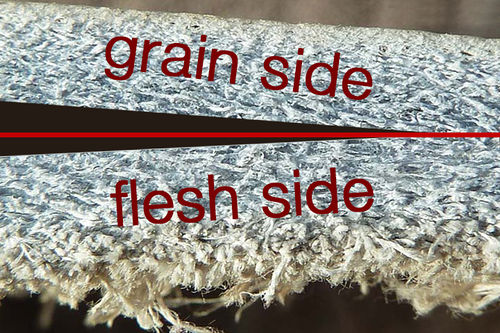
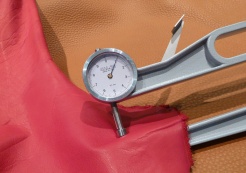
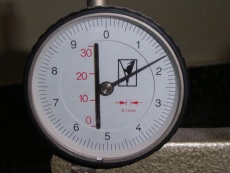
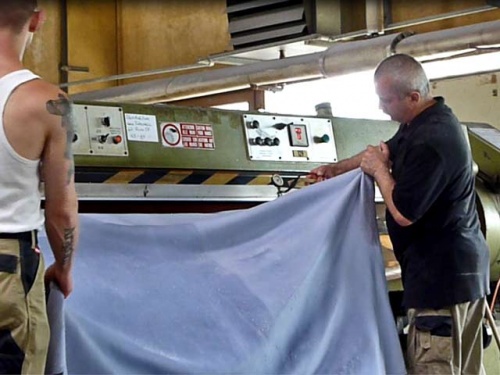
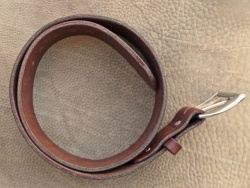
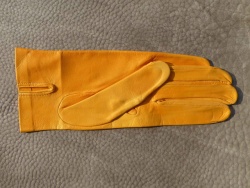

 a kotori web solution
a kotori web solution